
En esta foto sin fecha proporcionada por el Centro Nacional de Investigación de Primates de California, Los monos rhesus se ven en su recinto al aire libre en el Centro Nacional de Investigación de Primates de California en Davis, Calif. Un grupo de animales expuestos al humo de los incendios forestales cuando eran bebés han desarrollado pulmones que son aproximadamente un 20 por ciento más pequeños que otros monos rhesus. (CNPRC / Univeristy California Davis vía AP)
Primero vinieron las llamas una violenta tormenta de fuego impulsada por ráfagas de viento de 50 mph (80 kph) que incineró la casa de Kelsey Norton y mató a 85 personas en su comunidad.
Luego vino el humo, no solo del bosque, sino también de unos 14, 000 casas y su contenido que se quemaron, generando una columna densa que envolvió partes del norte de California durante semanas y dejó a Norton jadeando.
Y desde el incendio más de un año ahora, ha sido una enfermedad:infecciones respiratorias repetidas que minan la fuerza de Norton, interferir con su trabajo y dejar a la enfermera de cuidados cardíacos de 30 años preocupada por futuros problemas de salud.
"No quiero tener cáncer a los 50 porque inhalé humo a los 30, " ella dijo.
El saldo inmediato de vidas y propiedades perdidas cuando un incendio arrasó la ciudad de Paradise, al pie de Sierra Nevada, California en noviembre de 2018 está bien documentado. Aún se desconoce el impacto a largo plazo de la intensa exposición al humo que sufrieron los sobrevivientes de la tragedia y los cientos de miles de personas que viven en comunidades a favor del viento del incendio.
Los incendios forestales cada vez más intensos están quemando bosques desde todo el oeste de los EE. UU. Hasta Australia y avivando la preocupación entre los residentes y los profesionales de la salud sobre los impactos a largo plazo en la salud de la exposición al humo.
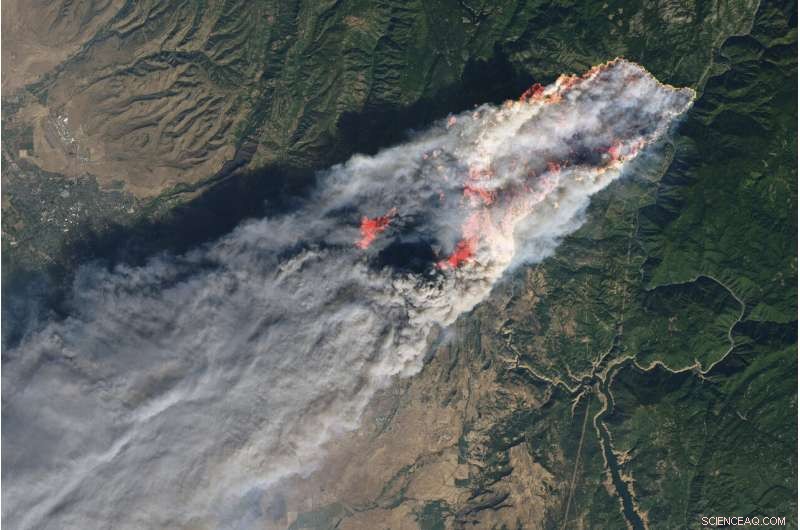
Esta imagen de noviembre de 2018 proporcionada por la NASA muestra llamas y humo del Camp Fire que estalló a 90 millas (140 kilómetros) al norte de Sacramento. Calif. Los incendios forestales cada vez más intensos que han quemado bosques desde California hasta Australia están avivando la preocupación por los impactos a largo plazo en la salud de la exposición al humo en las ciudades y pueblos afectados. (NASA vía AP)
El problema tiene implicaciones de gran alcance, ya que el cambio climático hace que algunas regiones del mundo se vuelvan más secas y más propensas a los incendios que emiten columnas de humo que pueden viajar miles de millas y afectar a millones de personas.
Los incendios sin precedentes que arden en Australia ofrecen el ejemplo más reciente, ya que cubren las principales ciudades con una peligrosa contaminación del aire. Humo de esos fuegos que empezó a arder en septiembre, para esta semana se había extendido por más de 7.7 millones de millas cuadradas (20 millones de kilómetros cuadrados) y se desplazó a través del Océano Pacífico para llegar a América del Sur. según la agencia meteorológica de las Naciones Unidas y el Servicio de Monitoreo de la Atmósfera de Copérnico.
Los fuegos han quemado a más de 2, 000 casas y mató al menos a 26 personas. Las autoridades ordenaron nuevas evacuaciones en Nueva Gales del Sur y el estado vecino de Victoria, ya que el aumento de las temperaturas y los vientos erráticos el viernes amenazaron con avivar decenas de incendios que aún se descontrolan.
Ambos estados emitieron advertencias sobre la calidad del aire peligroso para las áreas afectadas y dijeron que las personas con problemas de salud deberían considerar trasladarse hasta que el humo se disipe.
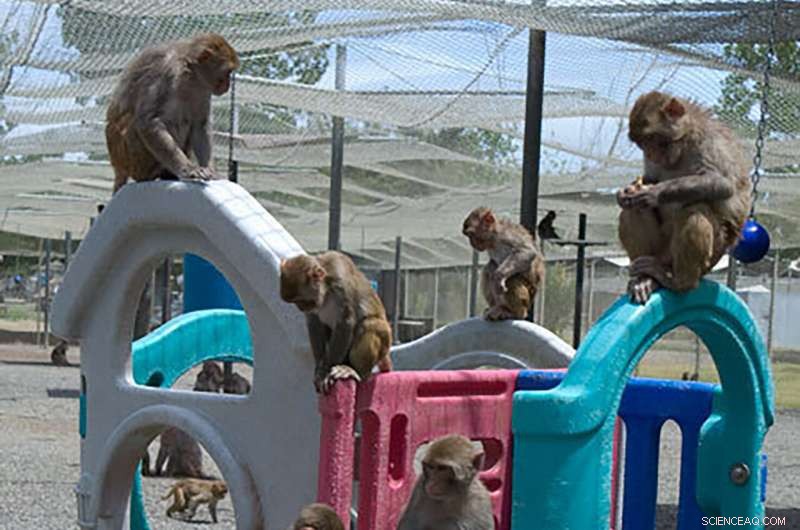
En esta foto sin fecha proporcionada por el Centro Nacional de Investigación de Primates de California, Los monos rhesus se ven en su recinto al aire libre en el Centro Nacional de Investigación de Primates de California en Davis, Calif. Un grupo de animales expuestos al humo de los incendios forestales cuando eran bebés han desarrollado pulmones que son aproximadamente un 20 por ciento más pequeños que otros monos rhesus. (Centro Nacional de Investigación de Primates de California / Universidad California Davis vía AP)
Agravando el peligro, expertos y bomberos dicen, es la proliferación de materiales de construcción y artículos para el hogar hechos de plásticos a base de petróleo, que van desde tuberías de plomería hasta revestimientos exteriores. Aquellos que arden más calientes y generan humo más tóxico que la madera, exponer a las personas a numerosos productos químicos peligrosos.
Los investigadores y los funcionarios de salud confían en que más personas se enfermarán y muchas morirán a medida que regiones como el oeste de EE. UU. Se vean más grandes. incendios forestales más intensos.
Se estima que 20, 000 muertes prematuras ahora ocurren anualmente en los EE. UU. Debido a la exposición crónica al humo de los incendios forestales. Se espera que se duplique a finales de siglo, según científicos financiados por la NASA, mientras decenas de millones de personas quedan expuestas a "ondas de humo" masivas que emanan de las llamas en los estados occidentales.
Pero si bien esos pronósticos ayudan a ilustrar los profundos impactos de un clima más cálido, no pueden predecir qué incendios resultarán mortales y qué individuos desarrollarán dolencias pulmonares u otras enfermedades.

En este jueves 21 de noviembre 2019, Foto, Kelsey Norton muestra fotos de su propiedad antes de que fuera invadida por un incendio forestal que incineró su casa y mató a 85 de sus habitantes en Chico. Calif. Norton dice que ha sufrido repetidas infecciones respiratorias desde que inhaló el humo del fuego que destruyó su ciudad natal de Paradise. (Foto AP / Matthew Brown)
Uno de los relativamente pocos estudios a largo plazo sobre el tema está en curso en el Centro Nacional de Investigación de Primates de California. Cincuenta monos rhesus que vivían en corrales al aire libre durante todo el año estuvieron expuestos a un período prolongado de humo de incendios forestales cuando eran bebés en 2008. Han desarrollado pulmones un 20% más pequeños que otro grupo de monos nacidos un año después. los investigadores encontraron.
"Es el modelo animal más cercano a replicar lo que sucede con los niños, "dijo Lisa Miller, director asociado de investigación del centro.
La diferencia apareció por primera vez cuando los animales eran adolescentes, y ha continuado a medida que han madurado. Es imposible para un ojo inexperto distinguir a los monos expuestos al humo de cientos de otros que comparten sus corrales. pero el equipo de Miller planea investigar cómo la disminución de la función pulmonar afecta los niveles de actividad de los monos.
A medida que los animales envejecen, cualquier enfermedad que desarrollen y cómo mueren darían pistas sobre el destino de los seres humanos muy expuestos al humo.
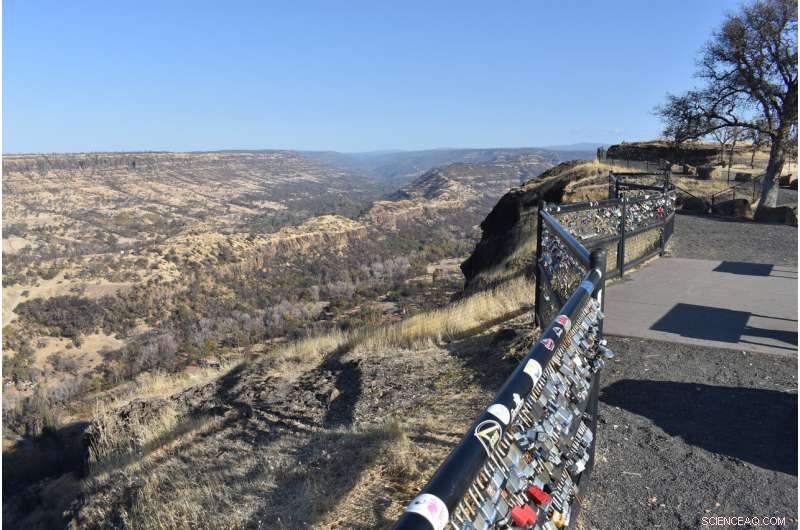
Este Viernes, 22 de noviembre 2019, La foto muestra la vista desde el patio trasero de Elizabeth Watling con vistas a Butte Creek Canyon, que se quemó en un incendio forestal de 2018 que destruyó la cercana ciudad de Paradise, Calif. Watling está participando en una Universidad de California, Estudio de Davis sobre los impactos en la salud de inhalar el humo del incendio que mató a 85 personas y destruyó a más de 14, 000 viviendas. (Foto AP / Matthew Brown)
Los estudios de bomberos forestales también brindan información sobre los riesgos de la inhalación de humo. Han mostrado tasas significativamente más altas de cáncer de pulmón y muerte por enfermedad cardíaca, dijo Michael Kleinman, quien investiga los efectos de la contaminación del aire en la salud y es profesor de toxicología ambiental en la Universidad de California, Irvine.
Los bomberos obtienen dosis de humo mucho más altas y más frecuentes, pero Kleinman dijo que se podría esperar un aumento proporcional de enfermedades entre el público en general expuesto al humo de los incendios forestales en California y el oeste.
"Es seguro decir que probablemente habrá más efectos a largo plazo, " Kleinman said. "Especially if those events happened over a longer period of time or more repeatedly, there will be cumulative damage to the lung and heart which eventually will lead to chronic disease."
As she fled with her boyfriend ahead of the fire that destroyed Paradise on the morning of Nov. 8, 2018, Norton said the smoke was so thick "it was like midnight."
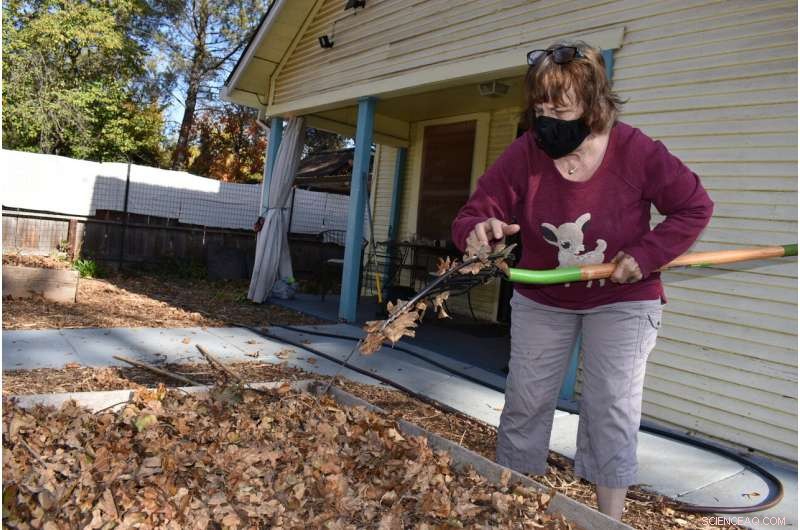
En este viernes Nov. 22, 2019, Foto, Elizabeth Watling spreads leaves over her garden to prepare it for winter while wearing a mask to protect against dust in Chico, Calif. Watling says her throat has been easily irritated since she was exposed to the huge smoke plume from a wildfire that destroyed the nearby town of Paradise the year before, killing 85 people and destroying more than 14, 000 viviendas. (AP Photo/Matthew Brown)
Unos días más tarde, she went back to work at a hospital in Chico, about 15 miles (24 kilometers) miles from Paradise. But smoke from the still-burning fire had made it inside the facility.
There weren't enough face masks to go around so Norton said she went without one for several days.
Initially she felt just a bit wheezy, as she had during the last major fire in the area about a decade earlier. But two weeks later she came down with a respiratory infection that brought fever and severe congestion.
When that finally cleared, she got another, then another—eight or nine infections in all over the past year.
"I just want to break this cycle of sickness, " ella dijo.
Norton says she never smoked, nor did her parents, and never had any respiratory issues prior to the fire. She missed so much work in the months after the fire that she got a warning from a supervisor.

En este jueves 21 de noviembre 2019, Foto, Dr. Nicholas Kenyon talks about the impacts of wildfires on human health at the UC Davis Medical Center in Sacramento, Calif. Kenyon says toxic smoke from houses and their contents that burn in wildfires is an emerging public health risk. (AP Photo/Matthew Brown)
To try to keep from getting sick, she rinses out her sinuses regularly and takes antihistamines to reduce inflammation in her airways. She also avoids large gatherings, including skipping office parties and two weddings, out of fear that she could pick up a virus. She tries to eat healthy and reduce stress by seeing a counselor.
Norton has been to a pulmonologist and two ear nose and throat doctors to little avail, and has been referred to a sinus specialist at Stanford University for further testing.
The pulmonologist who initially treated her, Dinesh Verma, said he sees a "direct correlation" between Norton's smoke exposure and her subsequent health struggles.
"The logical explanation definitely would be that intense smoke, basically chemical exposure, did damage the airways to the extent that they're now more susceptible" to infection, Verma said.
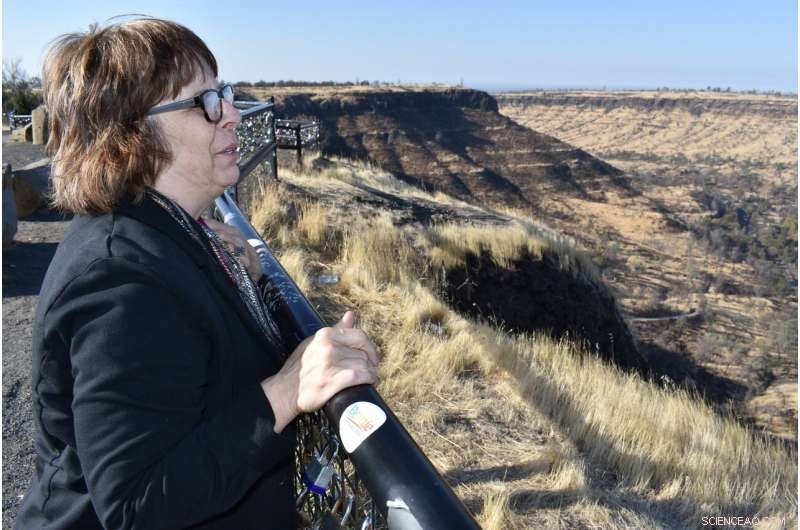
En este viernes Nov. 22, 2019, Foto, Elizabeth Watling looks over Butte Creek Canyon, which was burned in a 2018 wildfire that destroyed the nearby town of Paradise, Calif. Watling is participating in a University of California, Davis study of the health impacts of inhaling smoke from the fire that killed 85 people and destroyed more than 14, 000 viviendas. (AP Photo/Matthew Brown)
Verma said virtually all of his hundreds of patients from Chico and Paradise had complications after the fire that required them to be hospitalized or treated.
Most had preexisting conditions such as asthma and needed only a trigger to send them into a downward spiral. Predicting what will happen with otherwise-healthy patients like Norton is more difficult, él dijo.
Norton is among about 9, 000 people who responded to a health survey as part of a long-term health study of smoke exposure in Paradise and other California communities. The work is led by researchers at the University of California, Davis, who plan to track the lung health of a small number of those respondents in coming years by measuring their breathing capacity.
They're also collaborating with Williams at the primate center to see if the decline seen in the rhesus monkeys has parallels for human infants.
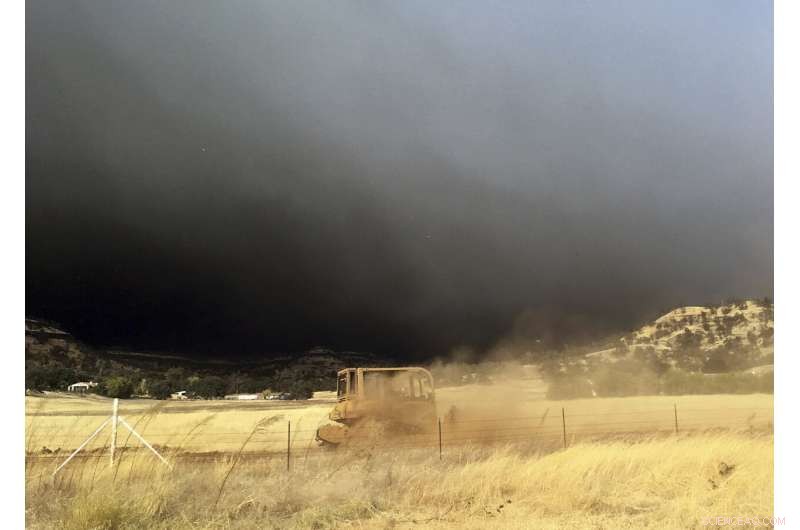
En este 8 de noviembre, 2018, foto de archivo, smoke from the Camp Fire darkens the sky on the horizon as a bulldozer cuts a fire line to protect Butte College in Oroville, Calif. Increasingly intense wildfires that have scorched forests from California to Australia are stoking worry about long-term health impacts from smoke exposure in affected cities and towns.. (AP Photo/Don Thompson, Expediente)
Dr. Nicholas Kenyon, a pulmonologist involved in the effort, said determining the health effects of smoke is increasingly urgent given the region's burgeoning population and more frequent fires due to climate change.
"We've got the population affected right now, but it's not going to be isolated to us. This is going to be the entire West, " Kenyon said. "Nobody's been really inhaling this kind of stuff from structures until now."
Another participant in the UC Davis study, 64-year-old Elizabeth Watling, lives in Chico and remained there through the fire so she could look after her 94-year-old aunt. She recalls smoke so thick that it left a layer of ash all over town, gray and light as snow. The air remained heavily polluted until it rained more than two weeks later.
When she gardens or does other outdoor activities, Watling wears a mask because her throat has become so easily irritated by dust. She fiddles with it often, taking the mask on and off to talk, and wonders how effective it will be since she can fit her fingers through gaps along her cheeks.

This Friday, Nov. 22, 2019, Foto, shows the entrance to the California National Primate Research Center in Davis, Calif. After a group of monkeys housed outdoors at the facility were exposed to wildfire smoke as infants, scientists are studying the animals to learn what kind of impacts breathing in smoke could have on children. (AP Photo/Matthew Brown)
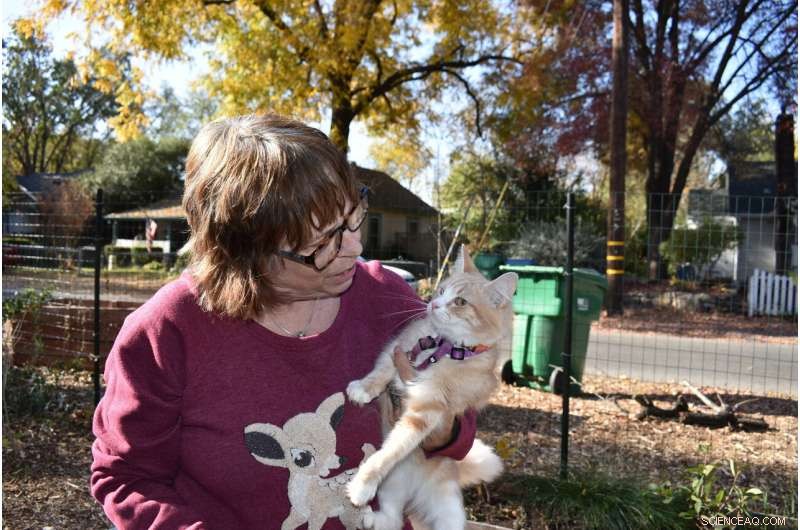
En este viernes Nov. 22, 2019, Foto, Elizabeth Watling holds her cat Tampopo as she talks about her health concerns over being exposed to wildfire smoke at her home in Chico, Calif. Watling says the fire that obliterated the nearby town of Paradise filled Chico's air with smoke for two weeks and left a coating of ash on the ground. (AP Photo/Matthew Brown)
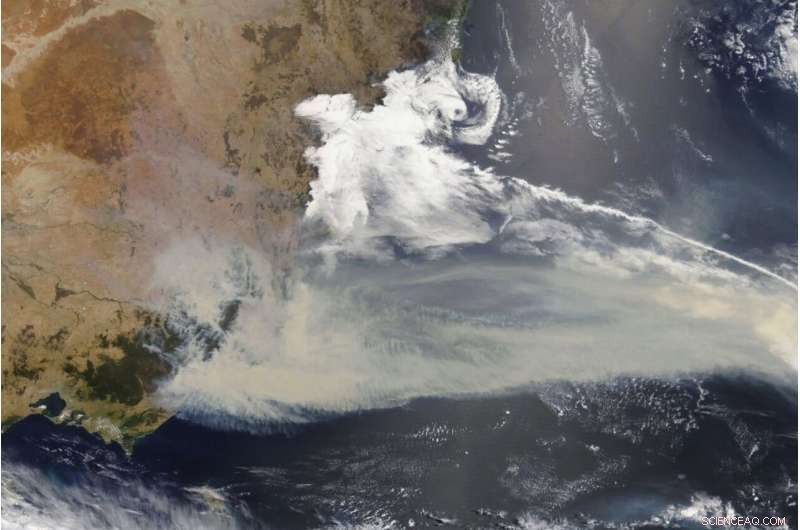
This Jan 2, 2020 file photo captured by NASA's Terra satellite and made available by the Moderate Resolution Imaging Spectroradiometer (MODIS), shows thick smoke blanketing southeastern Australia along the border of Victoria and New South Wales. Increasingly intense wildfires that have scorched forests from California to Australia are stoking worry about long-term health impacts from smoke exposure in affected cities and towns. (NASA via AP, Expediente)
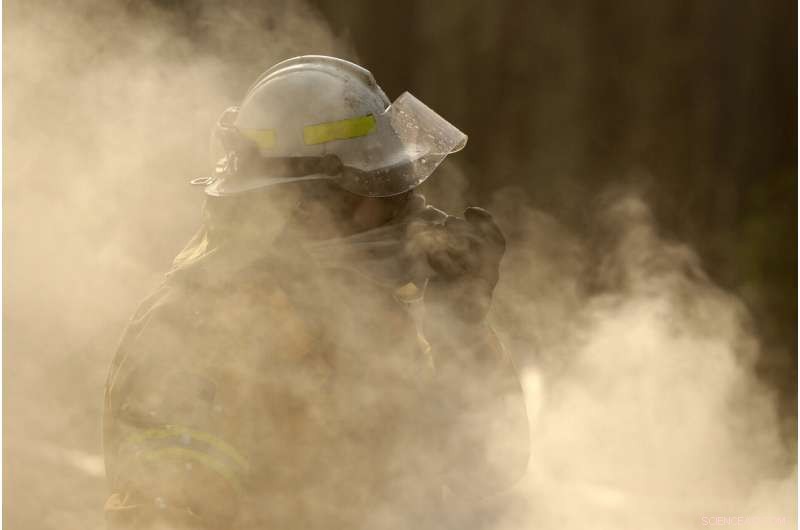
En este 3 de enero, 2020, foto de archivo, a firefighter covers his face from black smoke as he battles a wildfire near Bendalong, Australia. Increasingly intense wildfires that have scorched forests from California to Australia are stoking worry about long-term health impacts from smoke exposure in affected cities and towns. (AP Photo/Rick Rycroft, Expediente)
The health issues Watling blames on the smoke are less severe than Norton's—a scratchy throat that won't go away, coughs that linger, dificultad para respirar.
She expected those to go away but they haven't. Watling now figures that, given her age, she won't ever fully recover and the smoke could shave years off her life.
"I don't think the news is good for me, " ella dijo.
© 2020 The Associated Press. Reservados todos los derechos.